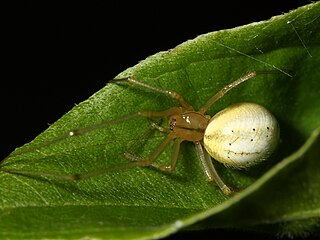
Theridiidae, also known as the tangle-web spiders, cobweb spiders and comb-footed spiders, is a large family of araneomorph spiders first described by Carl Jakob Sundevall in 1833. This diverse, globally distributed family includes over 3,000 species in 124 genera, and is the most common arthropod found in human dwellings throughout the world.

Oonopidae, also known as goblin spiders, is a family of spiders consisting of over 1,600 described species in about 113 genera worldwide, with total species diversity estimated at 2000 to 2500 species. The type genus of the family is OonopsKeyserling, 1835.

Linyphiidae, spiders commonly known as sheet weavers, or money spiders is a family of very small spiders comprising 4706 described species in 620 genera worldwide. This makes Linyphiidae the second largest family of spiders after the Salticidae. The family is poorly understood due to their small body size and wide distribution; new genera and species are still being discovered throughout the world. The newest such genus is Himalafurca from Nepal, formally described in April 2021 by Tanasevitch. Since it is so difficult to identify such tiny spiders, there are regular changes in taxonomy as species are combined or divided.

Scaffold web spiders or cave cobweb spiders (Nesticidae) are a family of araneomorph spiders closely allied with tangle-web spiders (Theridiidae). Like the Theridiidae, these spiders have a comb of serrated bristles on the hind tarsi that are used to pull silk bands from the spinnerets. Nesticidae contains 16 genera and about 300 species, many of which are associated with caves or overhangs. The genus Nesticus is the type for the family and is found throughout the world. The related Eidmannella has speciated considerably in Texas caves and includes some extremely localized species that are considered threatened. One species, Eidmannella pallida, is found in caves and under overhangs, but also in agricultural fields and other habitats away from such restricted areas. The genus Carpathonesticus is found in central Eurasia.
Selimus is a monotypic genus of Brazilian jumping spiders containing the single species, Selimus venustus. It was first described by George and Elizabeth Peckham in 1901, known from a single male found in Brazil. The species name is derived from Latin venustus "charming".

Ochyroceratidae is a six-eyed spider family, with 165 described species in ten genera. They are common inhabitants of caves and the tropical forest litter of South Africa, the Caribbean, Asia and South America. Considered an ecological counterpart of the Linyphiidae of the northern temperate zone, species are especially diverse in the Indo-Pacific region.

Argyrodes, also called dewdrop spiders, is a genus of comb-footed spiders that was first described by Eugène Louis Simon in 1864. They occur worldwide, and are best known for their kleptoparasitism. They can spin their own webs, but tend to invade and reside in their hosts' webs. This relationship can be commensal or even mutual if the dewdrop spider feeds on small trapped insects that are not eaten by the host. Some species can even prey upon the host.

Styposis is a genus of comb-footed spiders that was first described by Eugène Louis Simon in 1894. It is a senior synonym of Cyatholipulus.
Andasta is a genus of ray spiders that was first described by Eugène Louis Simon in 1895.
Argyrodella is a monotypic genus of Seychelloise comb-footed spiders containing the single species, Argyrodella pusillus. It was first described by Michael I. Saaristo in 2006, and is found on the Seychelles.
Ascetophantes is a monotypic genus of Asian dwarf spiders containing the single species, Ascetophantes asceticus. It was first described by A. V. Tanasevitch & Michael I. Saaristo in 2006, and has only been found in Nepal.
Indophantes is a genus of Asian dwarf spiders that was first described by Michael I. Saaristo & A. V. Tanasevitch in 2003.
Asygyna is a genus of Malagasy comb-footed spiders that was first described by I. Agnarsson in 2006. As of May 2020 it contains two species, found on Madagascar: A. coddingtoni and A. huberi.

Rhomphaea is a genus of comb-footed spiders that was first described by Ludwig Carl Christian Koch in 1872.
Sesato is a monotypic genus of African comb-footed spiders containing the single species, Sesato setosa. It was first described by Michael I. Saaristo in 2006, and is found on the Seychelles.

Seycellesa is a genus of spiders in the family Theridiidae. It consists of only its type species: Seycellesa braueri, which is endangered and endemic to the Seychelles.
Spinembolia is a monotypic genus of African comb-footed spiders containing the single species, Spinembolia clabnum. It was first described by Michael I. Saaristo in 2006, and is found on the Seychelles.
Stoda is a monotypic genus of African comb-footed spiders containing the single species, Stoda libudum. It was first described by Michael I. Saaristo in 2006, and is found on the Seychelles.
Michael I. Saaristo was a Finnish arachnologist, with a particular interest in the spiders of the Seychelles. The World Spider Catalog lists 61 genus names or synonyms and 109 species names or synonyms of which he is the sole or co-author.
Bardala labarda is the only species in the monotypic genus Bardala, a member of the comb-footed spider family Theridiidae. It was first described by Michael I. Saaristo in 2006, and is endemic to the coral atoll of Aldabra.








